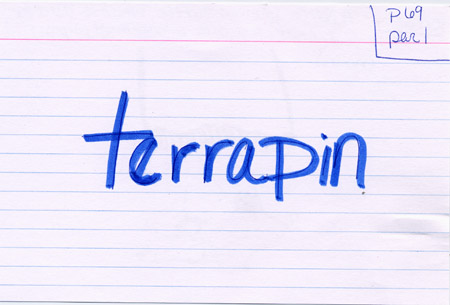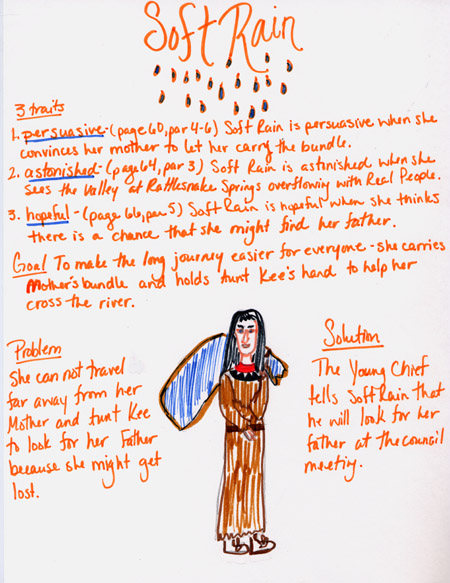Soft Rain
Fourth Grade (on grade level)
Section 4 (pages 51-75)
Discussion Director
The discussion director's job is to develop questions for the group
members to discuss about this section of the book. The focus is on
important ideas and issues in this section and designing questions that
address them.
1 Main Idea
1 MCEOG
1 Cause/Effect
1 Inference
1 Character Relationship
Main Idea
1. All of the following explain why the Tsalagi and white people
might not get along except for which one?
A. The white people think they are superior
to the Tsalagi.
B. The white people are forcing the Tsalagi
from their homes.
C. The white people's ways are encroaching
upon the traditional Tsalagi ways.
D. The white people are kind and take care
to bury the Tsalagi people who die along the journey.
(D. The white people are kind and take care to bury the Tsalagi
people who die along the journey.)
Passage Picker
The Passage Picker's job is to select significant passages from the
selections being read; determine why those passages are important; call
other group member's attention to the passage; and lead a discussion about
the passage.
Steps:
1. Pick
out a passage you would like to share.
2. Write
down the page and paragraph number.
3. Write
down the first two words and the last two words of your passage.
4. Write
down the reason you chose the passage, and explain why!
5. Ask
a question about your passage, and give an answer.
6. Write
down the Author's Purpose: To Describe, To Entertain, To Inform,
or To Persuade.
1. Passage One- Descriptive
2. Page 55, paragraph 1
3. Aunt Kee. . . their mouths.
4. I chose this passage because it explains how desperate the
caged Tsalagi people are and how they find joy and delight in the natural
and simple things. It makes me realize how much I take for granted.
5. The Tsalagi are as happy to have the rain come as we were
when Florida was burning out of control with wild fires.
6. Author's Purpose: To describe
Passage Two- Informative
Passage Three- Descriptive
Passage Four- Entertain
Word Wizard
The Word Wizard's job is to search the section being read for words
that are key to understanding what is happening in the story; note the
page and sentence where it can be found; check the dictionary meaning of
the word; lead a discussion about the meaning and intent of the word from
context and what the word contributes to the importance of the passage.
Steps:
1. Write down the word.
2. Copy the sentence from the book in which
the word appears.
3. Look up the word in the dictionary.
4. Using the context clues from the sentence
and the dictionary definition, write in your own words the
definition of the word.
5. Write the correct part of speech (noun,
verb, adjective, or adverb).
6. Write a question and the answer about the
word that would help you teach the word to your group,
refer back to the text,
or write a sentence using the Word Wizard word.
7. Make your Word Wizard card. Be sure
to include in big print, your word and the page and paragraph
number. On the other
side of the card should be a picture, the word, and the definition of the
word.
1. Terrapin, Page 69, paragraph 1
2. Faster and faster she moved, rattling the pebbles in the terrapin
shells tied to her legs.
3-4. terrapin- a North American turtle used for food, crafts,
tools, and entertainment purposes.
5. noun
6. Mother used the large terrapin shell as a bowl to knead the
dough.
7.


2. pondered, Page
61, paragraph 8
3. eerie, Page 73, paragraph 1
4. murmurings, Page 75, paragraph 1
Character Sketcher
The Character Sketcher's job is to develop a character map of major
characters in the section of text being read.
Steps:
1. Pick out a character that interests you. Choose three
words to describe this character.
2. For each trait, you will give proof (an example) from the
book (write down page and paragraph).
3. Write out the character's goal, problem, and solution (page
and paragraph).
4. Last, you will draw a picture of your character.
Soft Rain

Travel Tracer
The Travel Tracer's job is to create and maintain a map of movement
if the story involves travel (either physical or metaphorical).
Steps:
Describe the setting where:
1. the action begins and give page and paragraph
2. key events happen and give page and paragraph
(1. They are still being held in the first stockade . It
is very dusty and hot. There is no shade to be found, except for
the makeshift tents some have managed to construct. The river is
getting lower and the soldiers bring less water everyday, due to the lack
of rain. There is a smell of sickness in the camp. The mess
buckets are overflowing and the Real People are beginning to smell like
the soldiers (Page 51-53).
2. While at the first camp, Soft Rain learns that they are to
be moved to Rattlesnake Springs and then on to Indian Territory (Page 56).
During the journey to Rattlesnake Springs, up mountains and through
valleys and streams, a young Chief tells them that the Real People are
in charge. He gives them hope and decent food to eat (Page 61-63).
When they reach Rattlesnake Springs, they see a wide valley swarming
with thousands of Tsalagi. There are many empty stockades.
Hundreds of campfires make the air thick with smoke. There are animals
milling around the valley. There the young Chief tells Soft Rain
he will look for her father. He also explains that a council meeting
is to be held to decide on laws for their new home. Groups begin
to leave Rattlesnake Springs and head West (Page 64).
The trail on their way to the West is a difficult one. There are
steep mountains, many rivers, cold and wet nights, and rocks and pebbles
along the trail that make walking even more difficult. Sometimes
the days are hot and dry, and sometimes it rains for days at a time.
Old and young ones are dying and are left behind without receiving a proper
burial. Soft Rain, Aunt Kee, and Mother help a young woman who has
just lost her two young children. This section ends with "another
river to cross," (Page 73-75)).


